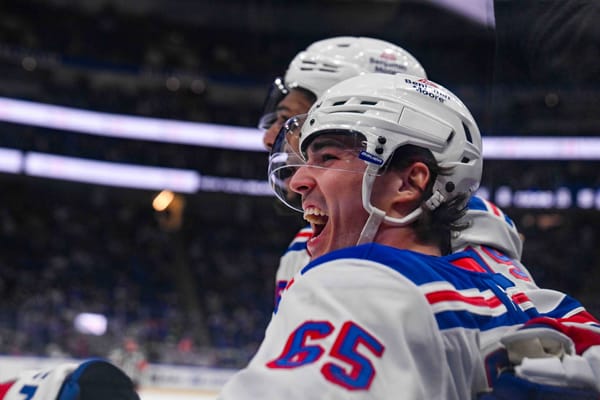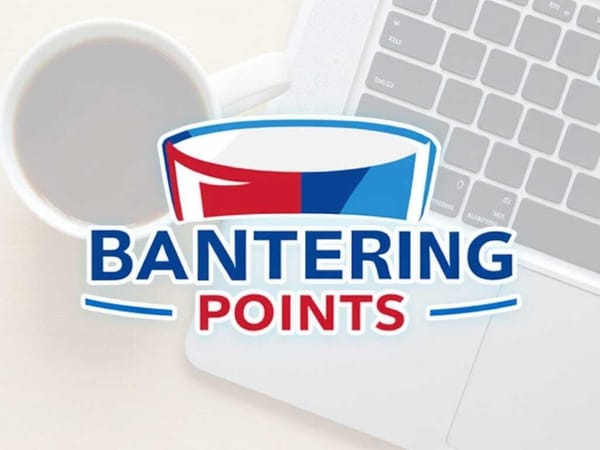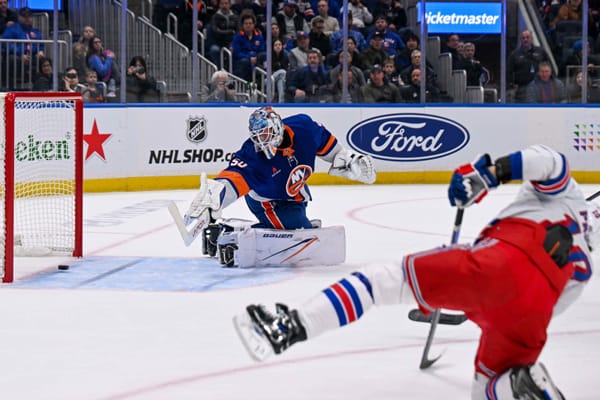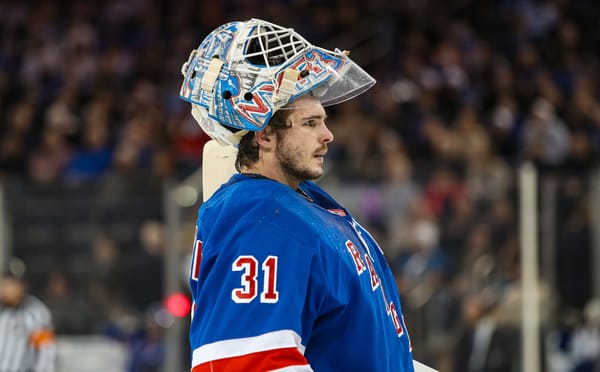Rangers Find Themselves in Familiar Territory With The Trade Deadline Creeping Up On Them
Upcoming stretch of games could have major implications on moves the franchise does/doesn’t make going forward.
The New York Rangers currently occupy a space that in the past has been referred to as “the dreaded middle,” Their upcoming stretch of games that includes a contest vs. the St. Louis Blues, a pair vs. the New York Islanders, and another matchup vs. the Columbus Blue Jackets could influence how the team approaches the trade deadline.
Prior to play on Friday evening, the Rangers hold a record of 21-18-4, and 46 points in 43 games. The New York Islanders and Pittsburgh Penguins, No. 2 and 3 in the Metro Division, have 57 points each, and both the Carolina Hurricanes and Philadelphia Flyers have 52 points; No. 1 and No. 2 in the Wild Card respectively.
Between the Canes, Flyers, and Rangers are the Florida Panthers (51 points) and the Columbus Blue Jackets (50), and you don’t need to have a firm grasp of mathematics to understand that the Rangers have a climb to make if they want to make the playoffs. Picking up six points in the three Metro division matchups coming up would help bridge the gap, but it’s hard to see a scenario in which the Rangers pick up points and the teams ahead of them drop points simultaneously. While it is only a six point spread, a lot would have to break the Rangers’ way.
The Penguins have battled injuries all year long, but have found a way to keep their head above water. Getting Sidney Crosby back should help them hold position within the division, and at the absolute worst they’d be relegated to a Wild Card spot. The Hurricanes have played .500 hockey over their last 10, and the return of Justin Williams could give them some extra depth. The Panthers haven’t seen a return on their Sergei Bobrovksy investment, but they are 6-4-0 in their last 10. And lastly the Blue Jackets are 6-2-2 in their last 10, and trending up ahead of their contest vs. the Rangers next week.
With that said, the Rangers need to be prepared to make tough decisions, and once they start making them it will be hard to walk them back. The organization is cognizant of this, and team president John Davidson spoke about the scenario the team was in before they departed for St. Louis.
JD on trade deadline.
— Vince Z. Mercogliano (@vzmercogliano) January 10, 2020
"We have to be ready for both sides... You’re in the hunt & a week later, you’re out of the hunt... The vision that I have is, whatever we do, we’re dealing w/ the business of hockey & the business of big picture trying to become a championship team."#NYR
As things stand, the Rangers have 15 players under contract next season, and $14,777,701 in cap space to round out their roster. This number is based off the current salary cap of $81,500,000. The team will need to navigate how they round out the 2020-21 roster, because the following season Pavel Buchnevich, Filip Chytil, Brett Howden, Ryan Lindgren, Libor Hajek, Yegor Rykov, Igor Shesterkin are restricted free agents.
At that time Marc Staal, Brendan Smith, and Henrik Lundqvist’s salaries will be off the books, but a good chunk of that money going off will be reinvested in that group of RFAs.
With that said, the Rangers need to think about who they are, what they think their team can be next year, and what they lack in composition to become a Stanley Cup contender. And if they do fall into a spot in which they need to consider making trades, they will have a lot of assets that can acquire pieces who will help them moving forward, or at the very least add draft picks which could be used to select players or as trade collateral.
The primary pieces of interest likely include, but are not limited to, impending UFAs Chris Kreider and Jesper Fast, as well as RFAs Ryan Strome, Tony DeAngelo, and Alexandar Georgiev.
What they do with Kreider is going to be a tough decision, because after rough start to the season he’s picked up his game and has 29 points in 43 games. That’s good enough for sixth among impending UFA forwards, and fourth among wingers. But Kreider is going to turn 29 in June, and his underlying numbers are way off from where they usually are which isn’t a good sign.
The Rangers may want to keep him long-term, and there are reasons why he’s someone worth keeping depending on price and term, but it would be in the team’s best interest to trade him and then re-engage with him on July 1. Anything more than four years on Kreider would be a mistake, and that’s the type of deal they could get done months from now.
On the most recent edition of 31 Thoughts the podcast, Elliotte Friedman said that the team’s mind isn’t made up yet, and could come down to the wire.
“My opinion is changing almost on the day on Kreider. I’ve had guys tell me that they think the Rangers are starting to think more and more about do they keep him? This’ll all play out over the next 6 weeks but [if] you get rid of him [he’s] hard to replace.”
— Phil Kocher (@PhilKocher) January 10, 2020
— Also Friedge
After Kreider, the attention likely shifts to Georgiev, someone else that Friedman talked about.
"I do know of one team — I know they were looking at [backup] goalies — and I said “have you thought about Georgiev,” and they said they don’t think he’s available because he’s in the Rangers long-term plans. We’ll see."
— Phil Kocher (@PhilKocher) January 10, 2020
— Friedge on latest 31 Thoughts pod. #PlayLikeANewYorker
It wouldn’t surprise me if the Rangers were being coy about Georgiev, because the last thing they want to do is give him away. He clearly has a certain level of value given what he’s done thus far, his age, and ability to be under team control at a reasonable rate, but goalie trades usually don’t get the best return — especially not in season.
Keeping three goalies on the roster isn’t something that will last long term, and although Shesterkin has looked very solid in his two starts thus far, I’d imagine the organization would love for him to gain playoff experience with the Hartford Wolf Pack. That can happen with the Rangers also trading Georgiev, but at this point the team will keep things close to the vest by rotating three goalies.
Other RFAs of note include Strome and DeAngelo, but we’ll start with Strome.
With 41 points in 43 games, Strome is nine points away from tying a career high of 50 set as a 21-year-old during the 2014-15 campaign, and 10 from setting a new personal best. His 19:26 a game are the most he’s ever averaged in a single season; his previous high was 15:54 a game set last season.
— Tom Urtz Jr. (@TomUrtzJr) January 1, 2020
I’ve jokingly resorted to posting the above as Strome continues to ride a high shooting percentage and provide offense while lacking defensively, and from an underlying numbers perspective, because it is what it is at this point.
This is not to say that there isn’t value in having offensive players. The league has a select few players who are elite offensively, defensively, and drive possession. Those players are bona fide superstars for a reason, and the rest of the league is full of players who are great in some areas, average in others, and bad in the rest. There are so many combinations of this, and I think you get the point. The numbers are brought up because given his history in the league of signing multiple short term deals; Strome wants to get paid.
No one should blame him for wanting to do so, but it becomes a question if that’s something in the Rangers’ best interest.
Another point that’s been cited is his chemistry with Panarin, and what’s the harm in keeping them together long term? I can understand that point of view, but there’s a high likelihood of the Rangers being able to find someone who posts equal or better results than Strome with Panarin at a much lower cost. That person could just be Filip Chytil, who projects to be a very good top-six center for the Rangers. When that time comes it leaves Strome as a very expensive third-line center.
That said, I’d imagine there’s bound to be playoff teams that view Strome as someone who could come in and play with a star player, or at the very least add some offensive depth. He makes just $3.1 million, and at the deadline the actual hit to the salary cap is lessened which could make him a real bargain.
So, I think you can recognize that Strome has played better than expected this season. You can recognize offensively he’s worked well with Panarin, and that there are cases of players not meshing with stars (i.e. the number of wingers who didn’t fit with Crosby), so he should get some credit. I think you can recognize all of that and say Strome, who is 27 in July, is peaking late as a player, and it doesn’t make much sense for the team’s long-term view. It isn’t anything personal against him, it’s just a business decision where the team has only so much room, and can’t afford to overpay players while simultaneously carrying dead cap space.
DeAngelo is the next player of interest, and him having a career year, and counting, is bound to put the team in a tough spot financially. In terms of goals above replacement, DeAngelo has been the Rangers’ fourth-most valuable player with 6.3 goals added. Ahead of him are rookie defender Adam Fox (7.4), Pavel Buchnevich (7.6), and Artemiy Panarin (16.9).
In a perfect world the Blueshirts would love to keep him long-term, but as an arbitration eligible RFA he’s in the perfect position to put the screws to the organization after agreeing to a one-year, $925,000 deal after the preseason started. For the most part all the numbers and charts are on DeAngelo’s side, and the Rangers don’t have much they can present to poke holes in his potential ask.
It doesn’t help that they have Jacob Trouba signed at $8 million a year, and while he was much closer to unrestricted free agency than DeAngelo is, Tony’s going to point out that they opened the vault for one RFA d-man, and now it is his turn. The number for him is likely to start at $5 million, and as he continues to pick up points that’s going to increase incrementally.
There’s also players outside the organization, including Joey Keane, and Nils Lundkvist, who add a wrinkle to the mix, and the aforementioned Fox who’s looked outstanding to start his career. It is highly unlikely the Rangers will try to part ways with Trouba, nor should they be looking to pull the rip cord after one year, so it’s quite possible that if the Rangers were to keep DeAngelo long-term they might do so with the provision he shifts to the left side, something he did back in his days in the OHL.
The depth on the left side is significantly weaker, but with Lindgren, Hajek, and Rykov as youngsters looking to get a chance to prove themselves, it would require the team to make a decision on Marc Staal. They technically could do the same with Brady Skjei, but if the Rangers are looking to open up cap space they’d be wiser to move on from the older player than one who has put up decent result on one of the weakest left sides in the league.
It’s unclear how the Rangers are going to maneuver through this situation, but at the very least they have options, of which both have pros and cons. DeAngelo being arbitration eligible is something that teams would consider at the deadline and offseason if he were made available, so there won’t be a rush to trade him if the team feels they can’t afford him long term, or feel confident with their other options within the system.
Lastly in terms of players whose future is up in the air, is Jesper Fast. Quickie is one of the organization’s veterans and has been with the organization since 2010. He made his debut during the 2013-14 season, and has been a roster regular since 2014-15.
He’s a heart and soul player who doesn’t always get the credit he deserves. In recent years he’s been deployed in the top-six more than he should, and the angst associated with that is because that has left some holes in the bottom six.
Fast has a bargain of a deal with a cap hit of $1.85 million, and on pace to finish with a career high 34 points.
For the longest time I have referred to him as Ruslan Fedotenko 2.0, and its a description that continues to describe the impact he has in his own end, and his ability to be a tertiary offensive contributor.
He’s been a loyal player for the Rangers, and over the last four seasons he’s won the Players’ Player Award which is given to the individual as selected by his teammate that “best exemplifies what it means to be a team player.”
Like some of the other players listed, Fast is in a position to get a nice deal for himself, as role players — Jay Beagle ($12 million over four years) comes to mind — have done quite nice for themselves in free agency over the last few years.
It’s just about the mid-January, and although there’s a lot of season left, I don’t think it is hyperbole to say that the next week of action will have a big impact on the Rangers’ season.
If the team were to fall into a double digit points hole behind the No. 2 Wild Card spot, it’s safe to say that the team would start pivoting to assessing what they can trade, and identify which players they want to learn more about for the rest of the season. Things could go the other way too, and the Rangers go on a run and get closer, and closer to that final playoff spot.
But the team could also stay in the same spot, and that would be the worst possible outcome, because remaining in the dreaded middle would delay the team even further, and could force an even more complicated trade deadline than projected.
Stats via Evolving-Hockey unless otherwise noted. Financial data via Cap Friendly.





